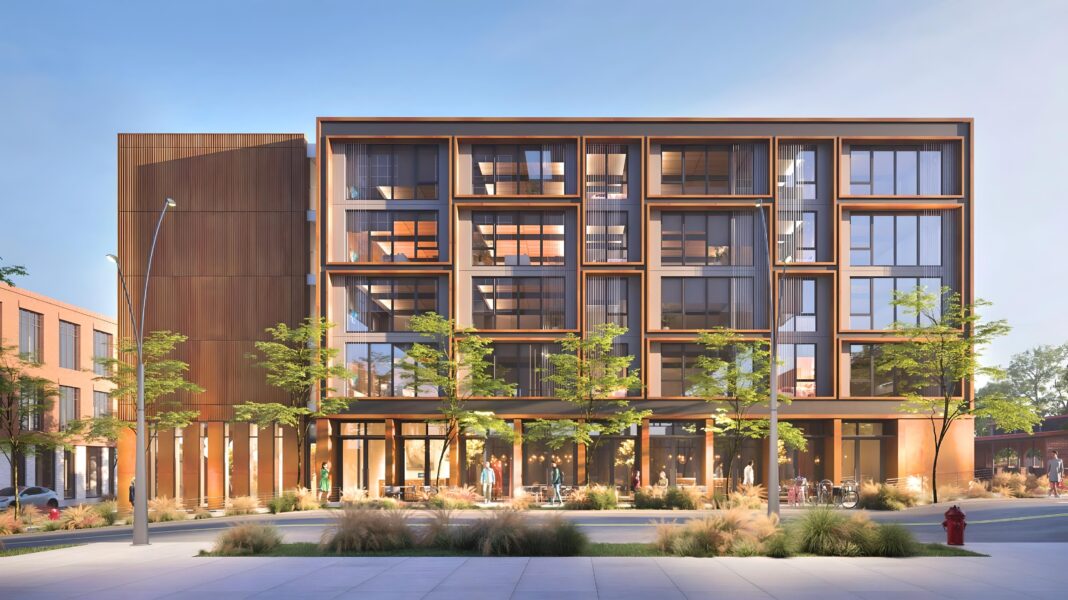One of the world’s first plug-and-play timber buildings is just weeks away from opening in Austin, Texas – with a Silicon Valley real estate start-up patenting a new type of building system, which it is looking to use on projects in Denver and Seattle ahead of a potential national rollout.
Juno East Austin, the five-storey, 24-unit mass timber building, will be fully constructed from 33 prefabricated timber parts—including floor slabs, columns, beams, bathroom pods, and a unitised facade—manufactured in a factory and locked into place by crews on site.
And in a major departure from the status quo, the new system, dubbed “a unique productisation platform,” allows architects to choose from a set menu of mass timber parts suitable for different projects – which are then manufactured by local fabricators or those best suited for the project.
Backed by BJ Siegel, a former Apple Design Director responsible for the design of Apple’s Macworld Expos, the developer – Juno Residential – is also supported by former Telsa executive Chester Chipperfield and investor Jonathan Scherr, who has successfully raised more than US $32 million in venture capital (VC) financing.

Providing a one-stop shop, “Juno is a modular-building company that aims to make urban building faster, more affordable, more sustainable and more efficient by using a system akin to an assembly line,” said Business Insider, who added the owners are applying the same “disruption model” to real estate as major tech companies have to smartphones.
Designed by New York Ennead Architects, Juno is trucking all the components flat-packed to the Austin site, where a five-person crew is currently clicking the pieces into place over a five-week period.
“Juno has developed a proprietary building system that uses repeatable components that can be easily configured or adapted to suit a specific site or local codes,” according to Juno, who said that “this simple-to-use yet sophisticated system helps expedite layout and planning, accelerates build schedules, and makes material sourcing more predictable.”
“Juno helps construction teams on its projects source directly from suppliers across the US and internationally,” according to Mr Scherr, who spoke to Forbes magazine about the concept earlier this year. “And while we want to power a new way of building, we need to make sure we specify materials and parts that won’t be single-sourced.”

The key is to streamline supply chains to create volume and scale.
Juno believes their design and production concept will create scale, something many modular manufacturers have struggled with in the past.
“If you are trying to scale, you cannot do that alone,” Mr Scherr said. You don’t scale with a single idea. We scale with an ecosystem of partners.”
“We are a hub instead of a typical highly fragmented process. Because we create direct relationships across each part of the development process, we can assemble a project faster and be much more efficient.”
Jonathan Scherr, the CEO of Juno Residential
As it stands, more than 2,000 timber mid-rise and high-rise buildings are either in planning, under construction, or already constructed across the United States, including more than 400 in Texas alone.
In March, Wood Central reported that US demand for timber buildings could grow 25-to-40-fold, given the right policy settings over the next half century, with the South responsible for 40% of timber buildings.
However, the actual demand for timber buildings could far outstrip estimates if the industry can demonstrate “the tangible and intangible benefits” of timber systems to fund managers, according to Noel Johnson, a prolific developer who spoke to Wood Central about tall timber buildings.
“The real estate development world is a world of billions of dollars of capital flow. And that’s part of the mindset that I would bring to our conversation from scaling up this sort of sensibility standpoint because all we’re looking to do is divert a percentage of that flow globally.”
Mr Johnson said that for mass timber to scale and go beyond being a novelty, it needs to meet the requirements of investment and pension fund money allocators – to appeal to the money markets.
“The core of every fund manager is to acquire differentiated assets – because we all know that will be a better asset,” whether it’s a mega-development – which can take years to realise fully or a smaller development with quick turnarounds.”
- In August, Mr Johnson will be a key speaker at the TimberConstuct conference in Melbourne, Australia. Visit TimberConstruct’s website for more information, including early bird registrations.






